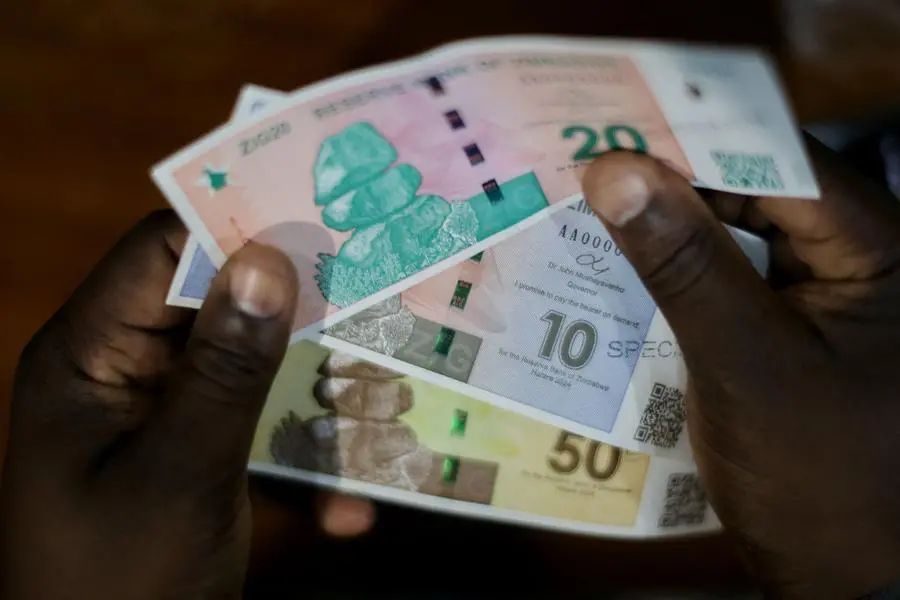PHOTO
The currency gained 0.2% to 13.53 per US dollar, according to data published on the Reserve Bank of Zimbabwe’s website on Tuesday.
The rand was trading at R18.47 to the dollar by 12h20 on Tuesday.
The ZiG, short for Zimbabwe Gold, was introduced on Monday, Zimbabwe’s sixth attempt to resuscitate the local currency. Its predecessor, the Zimbabwe dollar, lost value every single trading day of this year before being abandoned April 5.
Zimbabwe’s sixth try
The ZiG began trading on Monday as businesses struggled with the nation’s revamped unit.
Reserve Bank Governor John Mushayavanhu set the introductory exchange rate of 13.56 per US dollar for the ZiG, short for Zimbabwe Gold, where it started trading.
The daily exchange rate will be determined in the interbank market from now on, Mushayavanhu said during an April 5 presentation of his first monetary policy statement.
Five previous attempts to resuscitate a local currency have failed largely because the cash-strapped government resorted to printing money to fund the budget.
While Mushayavanhu repeatedly said that won’t happen under his watch, it will be an uphill battle for the ZiG to gain acceptance among a public who’ve repeatedly seen the value of their locally priced assets wither.
The authorities didn’t help confidence in the Zimbabwe dollar by demanding that payment for services including road toll fees and passports be made using greenbacks.
Peter C. Earle, senior economist at the American Institute for Economic Research, is skeptical the ZiG will be any more of a success than its predecessors.
There has been a “fundamental unwillingness of the government to abandon inflationary finance,” he said. “Even with the ZiG’s alleged commodity backing, fiat money can be printed and undermine the stoutest sound money plans.”
Banks, retailers, telecommunications companies and other firms spent the weekend reconfiguring their systems to adopt ZiG ahead of business resuming Monday, and it’s likely to take several days before all the glitches are ironed out. Only US dollar transactions were unaffected by the currency change.
A small number of the nation’s 19 banks were processing ZiG electronic transactions by early Monday, with larger lenders expected to come on stream later in the day, according to Lawrence Nyazema, president of the Bankers Association of Zimbabwe.
“By tomorrow we should be ready for trading and other services,” he said by text message. “In practice we need demand and supply from customers to really get going.”
The Zimbabwe Stock Exchange, which has 56 listed companies, said all share prices, price sheets and market reports will now be denominated in the new currency.
“All the ZSE indices will be rebased to 100 basis points,” said Justin Bgoni, the chief executive officer of the bourse. “The rebasing is necessary to allow the indices to accurately reflect the performance of the market in the context of the new currency ZiG.”
Stocks on the main exchange in the capital, Harare, have risen more than three-fold since the start of the year. A stocks surge in the southern African nation is usually cause for concern, as it points to an inflation spiral and investors seeking a hedge to protect the value of their money. Annual consumer prices rose to 55.3% in March, a seven-month high.
Stock traders said trading was very limited on Monday.
“Most of the players are waiting to see how this goes and I expect activity to remain muted for the next few days,” said Shelton Sibanda, chief investment officer at Imara Asset Management.
Traders are also “keeping an eye” on how banks will settle last week’s trades, which will be impacted by the currency switch, he said.
The new currency will pose a test for listed firms when they compile their financial statements, according to Lloyd Mlotshwa, the head of research at IH Securities, a Harare-based brokerage firm.
“From an audit perspective now that there has been a conversion, they’ll need to qualify all Zimbabwe dollar financials,” he said. “The next battle will be seeing how auditors handle that.”
Even before the official scrapping of the Zimbabwe dollar as legal tender, tell-tale signs pointed to authorities quietly giving up on defending it, an unusual departure from the previous stance of fiercely backing the local unit.
The currency breached several key milestones in one of its worst starts of the year since being brought back into circulation, plunging 40% on the street market in January. It then went on to lose value every single trading day of the year.
As a result, day-to-day transactions increasingly became hard to comprehend with zeros returning to the local currency evoking bitter memories for citizens of the days of hyperinflation.
Parallel Market
When it resumed circulation in 2019, the Zimbabwe dollar began trading at an official exchange rate of 2.5 per greenback. When it finally met its demise on Friday, it was officially trading at 30,671 per US dollar, having lost 80% of its value since the start of this year.
The switch to ZiG by service providers over the weekend also had an unintended consequence: cutting off the parallel market.
Most parallel market traders rely on using electronic payments to transact. Even those that trade in Zimbabwe dollar banknotes run the risk of holding worthless bills as they will be replaced by ZiG banknotes and coins. The new currency notes will be released April 30, the central bank said.
ZimPriceCheck.Com, a popular website that monitors official and unofficial exchange rates, did not have any parallel rates displayed on its site on Monday.
© Copyright The Zimbabwean. All rights reserved. Provided by SyndiGate Media Inc. (Syndigate.info).





















